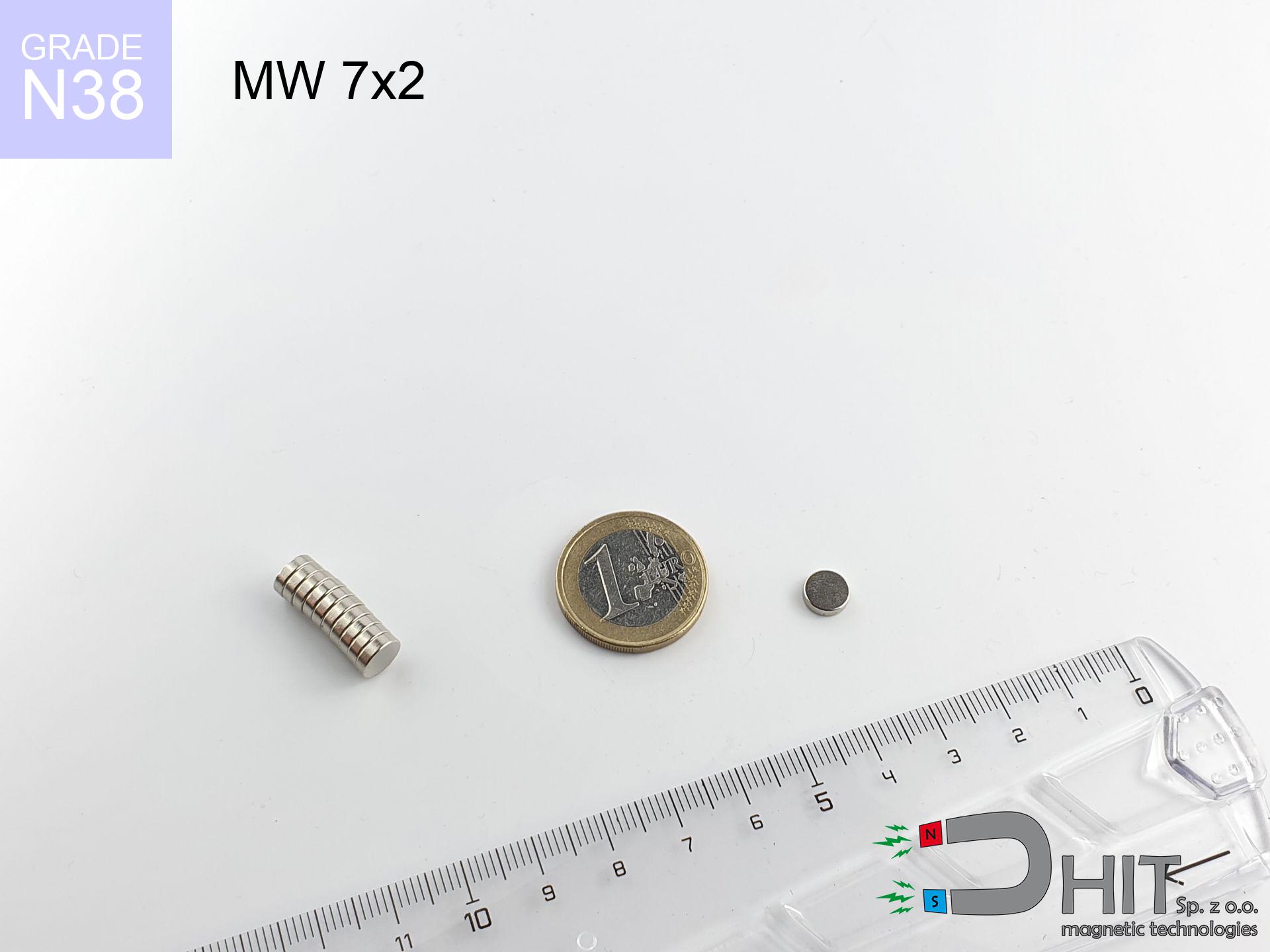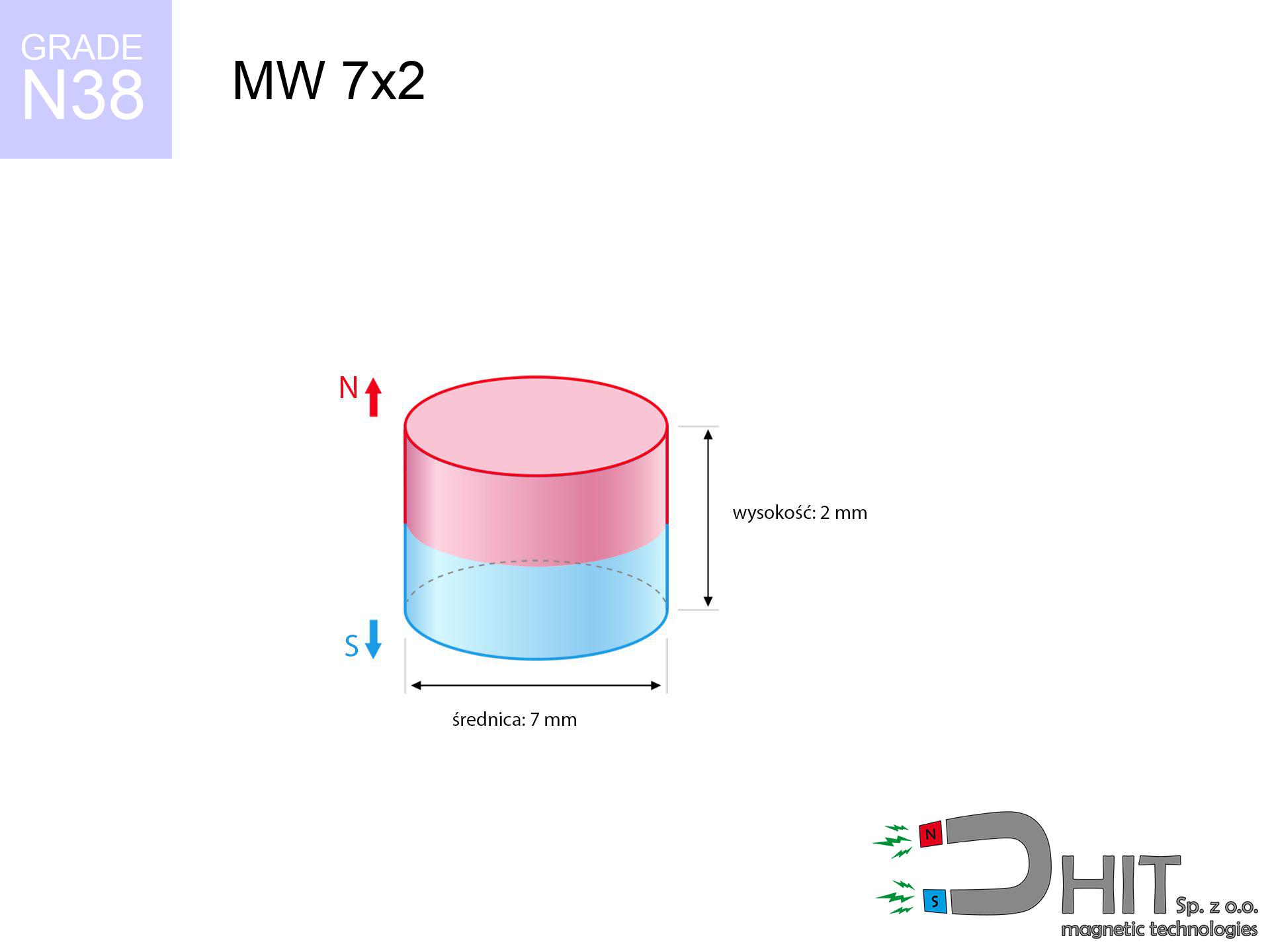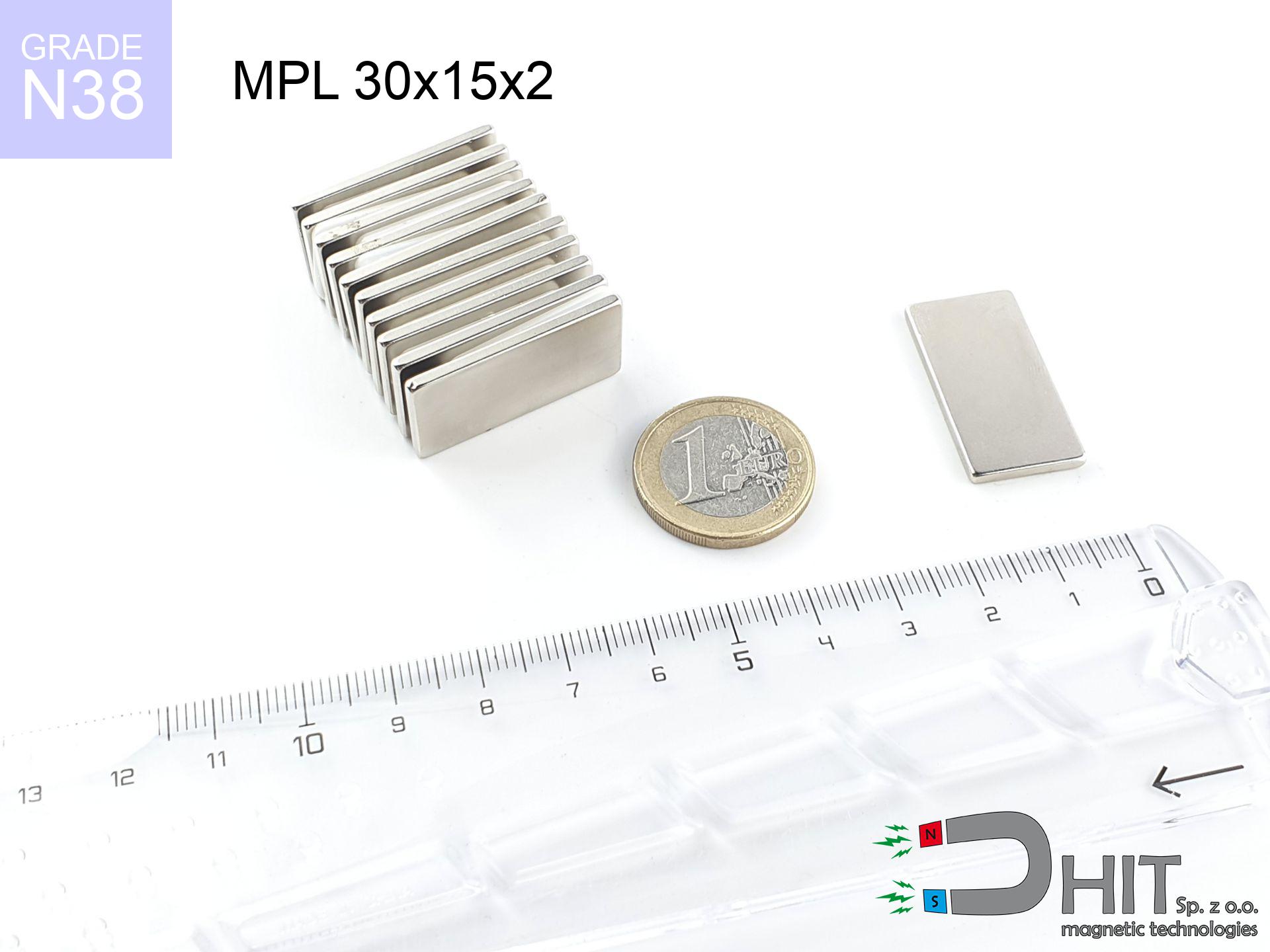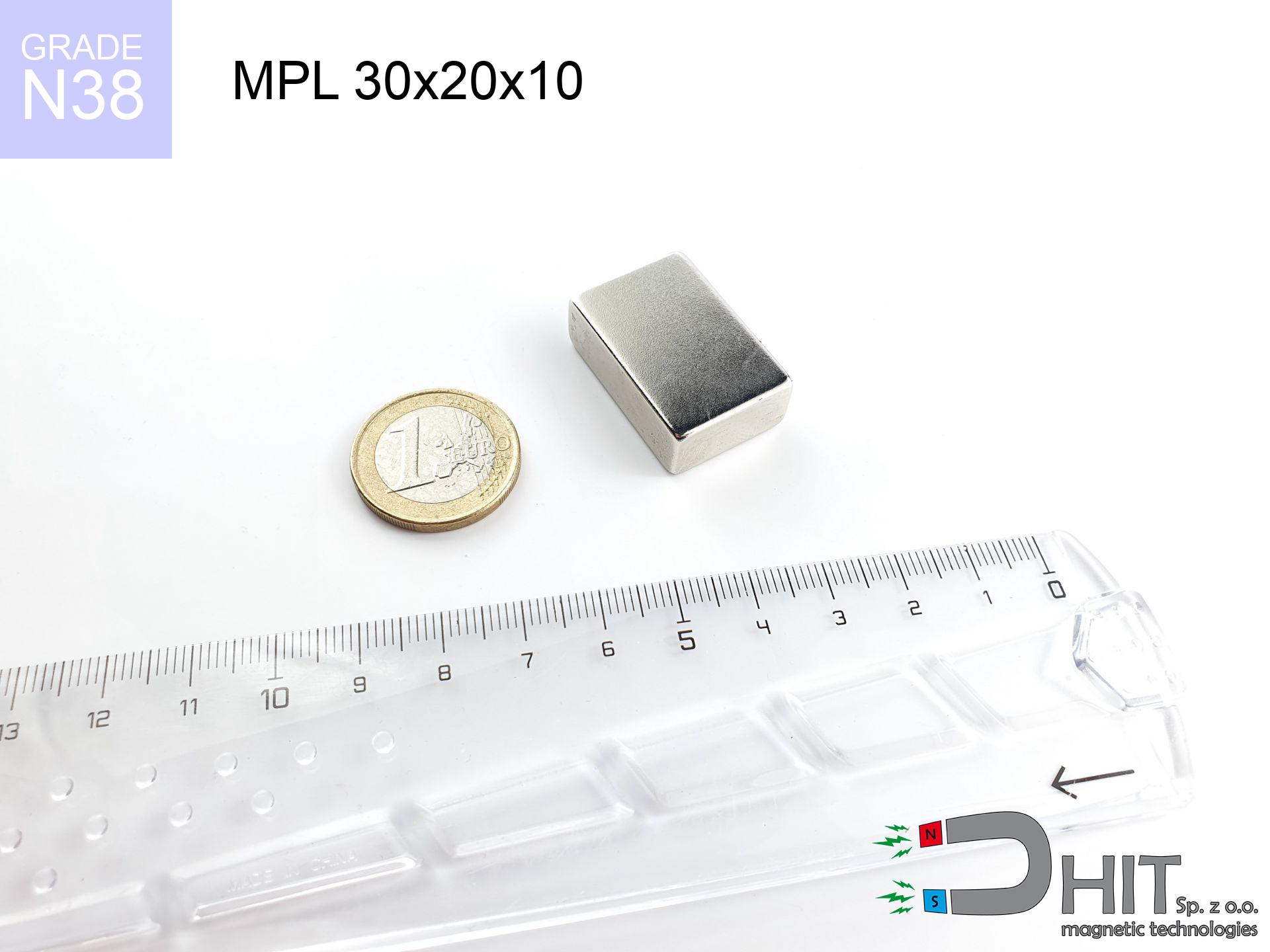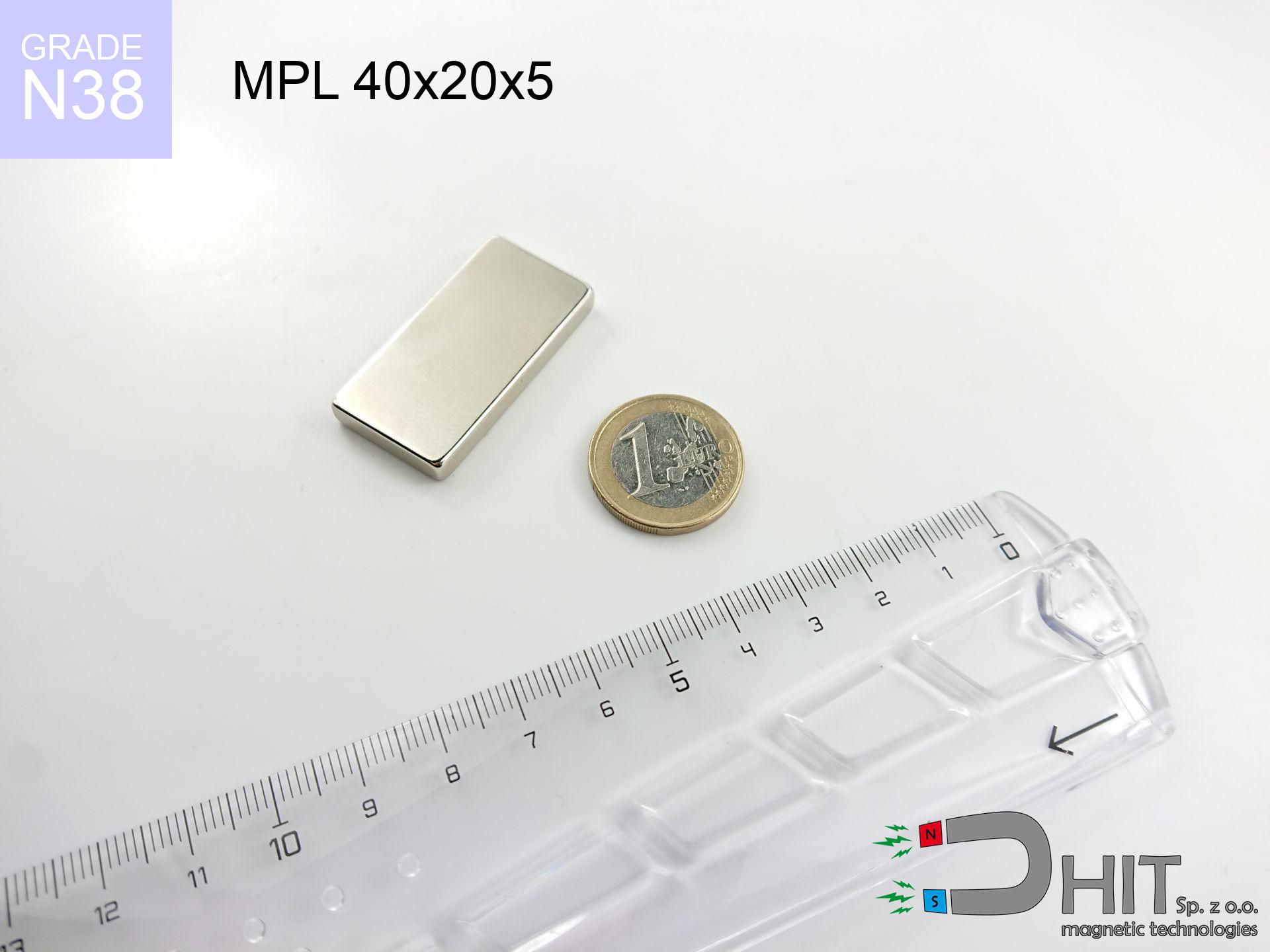MW 7x2 / N38 - neodymium magnet
cylindrical magnet
catalog number 010099
GTIN: 5906301810988
diameter Ø
7
mm [±0,1 mm]
height
2
mm [±0,1 mm]
magnetizing direction
↑ axial
capacity ~
0.77 kg / 7.55 N
magnetic induction ~
307.23 mT / 3,072 Gs
max. temperature
≤ 80
°C
catalog number 010099
GTIN: 5906301810988
diameter Ø
7 mm [±0,1 mm]
height
2 mm [±0,1 mm]
magnetizing direction
↑ axial
capacity ~
0.77 kg / 7.55 N
magnetic induction ~
307.23 mT / 3,072 Gs
max. temperature
≤ 80 °C
0.30 ZŁ gross price (including VAT) / pcs +
0.24 ZŁ net price + 23% VAT / pcs
bulk discounts:
need more quantity?Don't know what to choose?
Give us a call tel: +48 888 99 98 98 or get in touch through contact form on the contact page. You can check the lifting capacity as well as the appearance of neodymium magnet in our force calculator power calculator
Orders placed by 2:00 PM will be shipped on the same business day.
Specification: cylindrical magnet 7x2 / N38 ↑ axial
Magnetic properties of the material N38
Physical properties of sintered neodymium magnets Nd2Fe14B
Moreover, although neodymium is part of the strongest magnets, they are susceptible to corrosion in humid environments. Therefore, they are coated with a coating of gold to increase their durability. Interestingly that NdFeB neodymium magnets are about 13% lighter than SmCo magnets and, despite their power, easily break, which requires special caution during their handling. Therefore, any mechanical processing should be done before they are magnetized.
In terms of safety, there are many recommendations regarding the use of these magnets. It is advisable to avoid their use in acidic, basic, organic environments or in solvents, as well as in water or oil. Additionally, they can distort data on magnetic cards and hard drives, although data deletion using a neodymium magnet is not guaranteed.
In terms of properties in different environments, neodymium magnets are susceptible to corrosion, especially in humid conditions. Therefore, they are often coated with thin coatings, such as epoxy, to shield them from environmental factors and extend their lifespan. High temperatures exceeding 130°C can cause a reduction of their magnetic strength, although there are particular types of neodymium magnets that can withstand temperatures up to 230°C.
As for potential dangers, it is important to avoid using neodymium magnets in acidic conditions, basic environments, organic or solvent environments, unless they are adequately insulated. Additionally, their use is not recommended in wet conditions, oil, or in an environment containing hydrogen, as they may forfeit their magnetic strength.
List recommended items
Advantages and disadvantages of neodymium magnets NdFeB.
Apart from immense strength, neodymium magnets have the following advantages:
- They do not lose their power (of the magnet). After about 10 years, their power decreases by only ~1% (theoretically),
- They protect against demagnetization caused by external magnetic field very well,
- In other words, thanks to the shiny nickel, gold, or silver finish, the element gains an visually attractive appearance,
- They have exceptionally high magnetic induction on the surface of the magnet,
- Thanks to their high temperature resistance, they can operate (depending on the shape) even at temperatures up to 230°C and above...
- Thanks to the flexibility in shaping and the ability to adapt to specific requirements – neodymium magnets can be produced in various forms and dimensions, which expands the range of their possible uses.
- Wide application in the industry of new technologies – find application in hard drives, electric drive mechanisms, medical apparatus or other modern machines.
Disadvantages of neodymium magnets:
- They are fragile when subjected to a powerful impact. If the magnets are exposed to impacts, we recommend using magnets in a steel housing. The steel housing in the form of a holder protects the magnet from impacts, and at the same time increases its overall strength,
- Magnets lose their strength due to exposure to high temperatures. In most cases, when the temperature exceeds 80°C, these magnets experience permanent reduction in strength (although it is worth noting that this is dependent on the form and size of the magnet). To avoid this problem, we offer special magnets marked with the [AH] symbol, which exhibit high temperature resistance. They can operate even at temperatures as high as 230°C or more,
- Magnets exposed to a humid environment can corrode. Therefore, when using them outdoors, we suggest using waterproof magnets made of rubber, plastic, or other moisture-resistant materials,
- The use of a cover - a magnetic holder is recommended due to the limited production capabilities of creating threads or complex shapes in the magnet
- Health risk arising from small pieces of magnets can be dangerous, when accidentally ingested, which is particularly important in the context of children's health. Furthermore, tiny parts of these magnets have the potential to hinder the diagnostic process after entering the body.
Caution with Neodymium Magnets
Neodymium magnets are extremely fragile, resulting in their cracking.
Neodymium magnets are highly fragile, and by joining them in an uncontrolled manner, they will crack. Neodymium magnets are made of metal and coated with a shiny nickel surface, but they are not as hard as steel. At the moment of collision between the magnets, small metal fragments can be dispersed in different directions.
Dust and powder from neodymium magnets are flammable.
Avoid drilling or mechanical processing of neodymium magnets. If the magnet is crushed into fine powder or dust, it becomes highly flammable.
Do not place neodymium magnets near a computer HDD, TV, and wallet.
Strong magnetic fields emitted by neodymium magnets can destroy magnetic storage media such as floppy disks, credit cards, magnetic ID cards, cassette tapes, video tapes, or other devices. In addition, they can damage televisions, VCRs, computer monitors, and CRT displays. You should especially avoid placing neodymium magnets near electronic devices.
Keep neodymium magnets away from people with pacemakers.
Neodymium magnets generate very strong magnetic fields that can interfere with the operation of a pacemaker. This happens because such devices have a function to deactivate them in a magnetic field.
The magnet is coated with nickel. Therefore, exercise caution if you have an allergy.
Studies show a small percentage of people have allergies to certain metals, including nickel. An allergic reaction often manifests as skin redness and rash. If you have a nickel allergy, try wearing gloves or avoid direct contact with nickel-plated neodymium magnets.
Do not bring neodymium magnets close to GPS and smartphones.
Magnetic fields generated by neodymium magnets interfere with compasses and magnetometers used in navigation, as well as internal compasses of smartphones and GPS devices.
Neodymium magnets can attract to each other due to their immense internal force, causing the skin and other body parts to get pinched and resulting in significant swellings.
If joining of neodymium magnets is not under control, at that time they may crumble and crack. Remember not to approach them to each other or have them firmly in hands at a distance less than 10 cm.
Comparing neodymium magnets to ferrite magnets (found in speakers), they are 10 times stronger, and their power can shock you.
Please review the information on how to handle neodymium magnets and avoid significant harm to your body, as well as prevent unintentional damage to the magnets.
Neodymium magnets can become demagnetized at high temperatures.
Whilst Neodymium magnets can demagnetize at high temperatures, it's important to note that the extent of this effect can vary based on factors such as the magnet's material, shape, and intended application.
Magnets are not toys, children should not play with them.
Neodymium magnets are not toys. Do not allow children to play with them. In the case of swallowing multiple magnets simultaneously, they can attract to each other through the intestinal walls. In the worst case scenario, this can lead to death.
To illustrate why neodymium magnets are so dangerous, see the article - How very dangerous are very strong neodymium magnets?.


